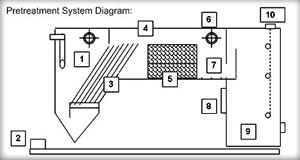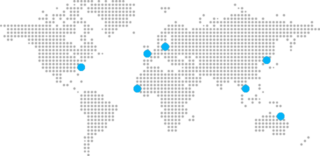In short, a clarifier oil water separator is designed to remove both heavy suspended solids AND free and dispersed, non-emulsified oil from the oil water mixture.
Oil Water Separators
Choosing the right oil water separator can seem daunting. Just as not all applications are alike, not all separators are made alike. Customers should understand a few important points to make sure they’re getting what they pay for.
The HD Q-PAC media has vastly superior properties compared to the traditional media used in oil-water separators. These properties result in a more efficient and effective separation than that attained by traditional coalescing media, for a variety of reasons.
In a typical oil-water separator with traditional media, incoming oily water slowly flows from the inlet through a media comprised of a series of parallel, inclined plates. As the oil droplets in the water coalesce with other oil droplets on the media surface, the oil droplets grow in size and travel up the plates to the water surface. This design, however, allows some water droplets to by-pass the plates and flow through the separator, requiring secondary polishing filters to achieve the required effluent characteristics. The shapes and configurations of tradition coalescing media also traps particles and sludge on the media itself, resulting in a sludge build-up and a reduction of effective flow through the separator.
The HD Q-PAC media provides improved performance in oil-water separators over traditional media due to the following properties:
– A larger amount of surface area per cubic foot of media allows for greater oil drop coalescence. HD Q-PAC media has 132 ft2/ft3 surface area for oil droplets to contact. Other typical coalescing media have about 48 ft2/ft3 to 68 ft2/ft3.
– A more efficient first step separation reduces the need for a second polishing step. HD Q-PAC media removes 99.9% of oil droplets 20 microns in size and larger. This meets EPA Method 1664 Revision A and European Standard EN 858-1.
– An open design eliminates trapping of particles and subsequent clogging of water channels. Oil water separators with HD Q-PAC media require fewer maintenance shut-downs and separates oil and water faster.
– Where higher-than-normal operating temperatures are required, HD Q-PAC media outperforms its competitors. HD Q-PAC media works effectively in temperatures up to 212°F, versus a maximum temperature of about 120°F for competing media.
Oil Water Separators are designed to effectively remove floating solids and non-emulsified oil from an oil and water mixture on a beginning to end flow process through the separator. The mixture of oil and water enters one end of the separator and slowly flows toward the other end. If oil and water are mixed and not emulsified, the oil originally exits the water in different sizes of droplets. When the drops of oil are large enough and the flow is laminar, or moving in a smooth and gentle flow with no turbulence, the oil droplets will separate before reaching the end of the separator tank.
Since the calculations of Stokes’ Law are supported on a zero velocity flow, a Reynolds number lower than 500 guarantees optimal separation. The majority of oil water separators commonly use the parallel corrugated plate design which causes oil droplets to enlarge in size and ascend to the surface of the water. Flow of oil and water through the oil water separator follows several main steps after entering the separator:
- Mixture particulates, heavier sludge drops from liquid and is confined in sludge hopper.
- Lighter weight particles from mixture travel up inclined plates.
- Inclined plates begin separating the mixture.
- Some oil will rise to the top of the separator.
- Particulates drop down into sludge hopper.
- Remaining mixture travels on through coalescing media packs.
- Most remaining small oil particles attach to media and coalesce with retained droplets.
- Retained droplets form larger oil droplets.
- Larger oil droplets float, rising to top of separator.
- Oil volume reaches a certain level and is pumped or drained to a storage tank.
- Clean water travels on to a chamber and goes through a final polishing pack.
- Clean water is discharged from the separator.
It is especially essential for the flow of the liquid through the oil water separator to be laminar to act in accordance with Stokes Law. To achieve this type of flow, a design that is cross-fluted and having an internal structure of connecting channels between adjoining plates can be used. With this design and the enlarged surface area, the effectiveness of the oil water separation process is greatly enhanced.
An oil water separator needs to be properly and regularly maintained to stay in good working order. When these devices are not drained and cleaned out religiously, oils and other debris will stop them up and make them useless. This can cause the levels of oil in the released water to go beyond the effluency limits indicated.
Models of oil water separators that sit above the ground are somewhat easier to keep clean since everything is easy to get to. This is because there are no tight spaces and plates can be easily taken out, cleaned and replaced. All above-ground types can be maintained from the ground level. Also, solid waste can easily be removed via a large opening at the ground level.
If using a below ground oil water separator, it is particularly essential that you follow a strict schedule of maintenance. Because the unit is underground where it can’t be seen, it is far more likely that you will forget to clean it. Here are the maintenance procedures to follow for this type of oil water separator.
After one month of use, make sure you inspect and clean the inlet area in the following way:
- Turn off the influent water to the unit.
- Open the unit cover.
- Remove any oil and dispose of it in a way that complies with company and legal procedures.
- Drain the water from the separator.
- Measure the depth of the leftover solids and write it down. This will serve as a framework for scheduling future maintenance and cleaning.
- If necessary, dispose of the solids.
After doing all of this, you will need to clean the media plates. They can be cleaned while still in the unit or removed for cleaning. To clean them without removal, stick a low pressure hose in between the plate spaces on the plate packs. Any dirt flushed from the plates should be removed through the drain on the hopper outlet.
For cleaning the plates outside of the oil water separator, rinse them down with a low pressure hose while taking extreme care to avoid getting the discharge on the ground where it has access to groundwater. All that needs to be removed is the sludge and oil buildup.
When this is done, check the tank for damage and repair the internal coating if needed. To start the separator again, just place the plate packs back into the unit as they were before. Ensure that they are securely installed to prevent them from floating when the unit resumes functioning. Maintenance should be carried out regularly by a qualified professional, depending upon the unit’s application and the amount of oil and other debris accumulated.
To receive a quote on a separator for your particular needs, call us today at 800-453-8639.

It is a well known fact that oil and water do not mix. But separating the two before releasing the wastewater into sewers or open water areas is no easy feat. Because millions of gallons of oil wastewater have the potential to get into our water supply , wetlands and environment each year, the EPA and state agencies have implemented guidelines for keeping our environment free of oil contaminated wastewater. While the process of separating oil and dirt from wastewater is not simple or inexpensive, it guarantees all of us will have uncontaminated water supply and wetlands for decades to come.
How Problems Occur
Operating and washing heavy machinery will combine water with oil, grease and grime. Without treatment, this wastewater would release harmful contaminants into the environment.
Solutions
Case studies conducted by Wash Bay Solutions prove that much of the oils and dirt from contaminated wastewater can be removed before it is discharged to the sewer. One way this is done is by putting the wastewater through a specially-designed clarifier separator equipped with inclined plates to drop out the solids and advanced coalescing media to remove the oils. If the water needs to be re-used, it can be put through more filtration.
Result
Water without oil and dirt contamination can be reused or safely discharged. By using oil water separators on wastewater, we are using good “Green” business practices to both save money and be good stewards of the environment.

[Diagram Details Below]
- Stainless Steel Inlet Compartment – The water is pumped into the system through a non-clogging diffuser pipe to distribute the flow. The inlet chamber is designed to reduce suspended solids, dissipate energy and begin separation.
- Sump Pump – Water is pumped into the system via an air diaphragm sump pump.
- Inclined Plates – Inclined plates above the sludge chamber catch suspended particles as the water stream moves into the separation chamber.
- Separation Chamber – After the water travels up the inclined plates, it flows into the stainless steel separation chamber containing the coalescing media.
- Coalescing Media Packs – The high efficient coalescing pack in the separation chamber further slow the water velocity so oil drops out of suspension and clings to the media. This media will remove 99% of free oil droplets 20 microns or larger.
- Oil Skimmer – The oil that has dropped out of suspension is then skimmed off the top of the separation chamber and into a tank for easy removal.
- Baffles – An underflow weir will prevent re-suspension of solids while an oil retention weir will keep the oil in the separation compartment.
- Ozone Generator – The water is injected with ozone to kill odor-causing bacteria.
- Clean Water Chamber – The third stage is a clean water chamber where the clean water will flow out for reuse to the drain.
- Float Control System – SPT Series Systems come with optional control systems for simple, automatic operation.

